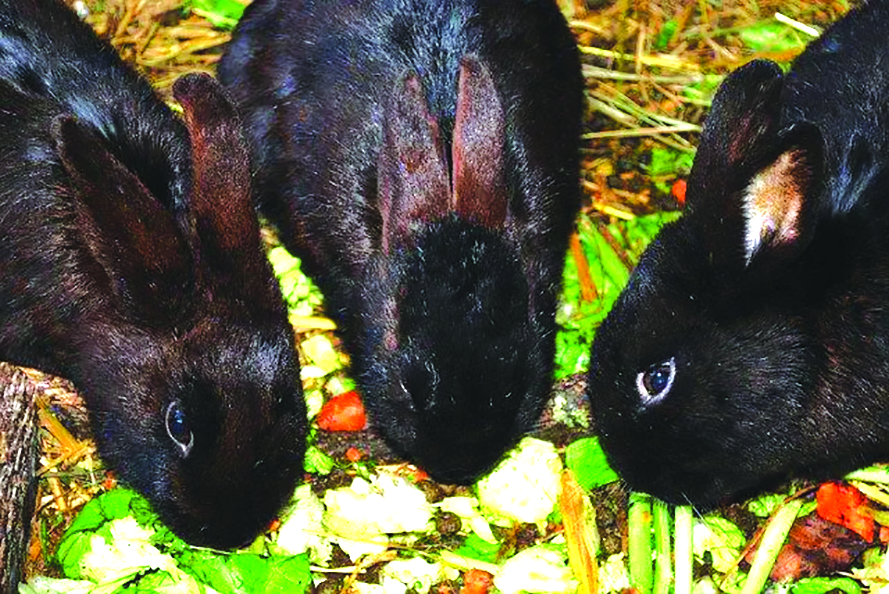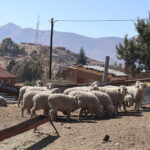Kabelo Masoabi
The COVID-19 restrictions presented a retrospection period for Matlou Majoro to diversify his livestock rearing.
At the time, he had too much time on his hands, yet the food consumption market was pregnant with food produce. People were confined at home and needed a variety of food.
At that time, Eureka. He thought of “rare breeds” and started looking at different information on rearing rabbits.
He had discovered the nutritious benefits of rabbit meat and wanted to venture into a sector with limited to no competition; he wanted to be a pioneer.
He legally registered Boiketlo Farms and started rearing roosters, chickens, rabbits, geese, and ducks.
After two years in it, he supplies different outlets and has a loyal customer base of people who consume his rare livestock.
“Boiketlo is a registered farm striving to ensure that rabbit meat gains popularity among consumers looking for sustainable, nutritious, and delicious food choices. As it is still an uncommon meat, it doesn’t have a specific name, like steak for beef, so it is just known as rabbit meat. The meat is usually classified along with chicken and turkey as white meat,” Majoro explained.
According to the Food and Agriculture Organisation’s (2021) report, The State of the World’s Animal Genetic Resources for Food and Agriculture—Lodges Sector: Rabbits, in developing countries, rabbit farming is becoming one of the fastest-growing agricultural enterprises and the preferred alternative source of meat production.
The report’s indications show that the global production of rabbits increased by an average of 1.1% annually between 2010 and 2019, resulting in a total production of 1.35 million metric tonnes in 2019.
The report also noted that this increase was observed in most regions of the world, with the highest annual rate of 4.4% observed in Africa. The study reported that growth is being propelled by rising populations, changing meat consumption patterns, and the current effects of climate change.
After two years in the field, Majoro found rabbit farming to be a profitable agribusiness and called on the government through the Ministry of Agriculture, Food Security, and Nutrition to promote it through education and extension services, as well as providing short-term credit to farmers to help them commercialise production.
Based in Ha Moramang, Kolonyama in Leribe, Majoro encourages investment in the commercialization of rabbit production or its promotion as a way of improving livelihood and reducing poverty in rural communities where production inputs are relatively cheaper and poverty is endemic.
According to the farmer who founded Boiketlo Farms with the purpose of rearing and breeding rabbits in May 2021 amid COVID-19, commercialization also prioritises food quality and a safety standard, which ensures consumers have access to safe, nutritious food.
The absence of commercialization in the rabbit industry, as the report also indicated, can prevent farmers from using cutting-edge techniques and technology that increase productivity and yields, resulting in lower production levels and lower farmer profitability.
The top five rabbit meat-producing countries in 2019, which included China, Spain, Italy, Egypt, and France, accounted for more than 60% of the world’s total production.
Gearing for expansion, Majoro has already started distributing packaged and branded rabbit meat to several food stores in the country, as well as trading from another branch at Motimposo in the capital city of Maseru.
“Rabbit farming is one of the sustainable agriculture enterprises due to its minimum initial investment, a small required area for production, and the ability to feed on feedstocks that are undesirable for humans.
“The rabbit industry has a lot of livelihoods and economic potential, and rabbit has emerged as one of the most suitable means of producing high-quality animal protein that could make a significant contribution towards bridging the gap between local production and demand for animal protein in Lesotho,” Majoro explained. However, he indicated that constraints such as inadequate production of rabbit to meet customer demand serve as hindrances to the growth of the industry.
“Our farm is one of the few distributing limited meat to several local food stores and individuals,” he explained.
In Lesotho, increasing demand for sustainable and ethical meat products and changing dietary preferences are some trends that may lead to the expansion of the rabbit meat industry in years to come, Majoro indicated.
He said most people are still not aware that rabbit meat is sold at some local food stores.
“At Boiketlo Farm, we usually use social media and exhibition platforms to sensitise local consumers about the benefits of consuming the product. Lean meat is highly nutritious and possesses a healthy source of protein, essential vitamins, and minerals, yet it remains the unpopular choice of meat among local consumers. I have learned the strong deterrent factor why people do not eat rabbit meat is its unavailability in the market because of low supply,” he said.
Elaborating further on the challenges to rabbit farming expansion, he said one of the main tests facing the rabbit farming industry in Lesotho is a lack of formal market channels.
“This means that while some farmers can sell their produce to specialty food stores and restaurants, we struggle to find buyers for their rabbit meat. Invariably, limited market success results from low consumer demand, insufficient promotion, inconsistent product supply, unreasonable prices, competition from other meats, a lack of product diversification, and poorly developed marketing channels, but we are working on improving our market reach,” he said.
On the other hand, he highlighted compelling ethical and environmental aspects of rabbit meat production, proving that breeding rabbits for meat has a significantly lower carbon footprint compared to traditional livestock. He said the animals themselves require less space and resources, making rabbit farming more sustainable and eco-friendly.
“Rabbit meat is not as expensive to produce as many people assume. Rabbits are herbivores that do not consume large amounts of feed; the most important food item to offer them is a mixture of grasses classified as hay. Fresh water should be available at all times. They also do not require a large amount of space, which makes them easy and cheap for both subsistence and commercial farmers to produce. At the farm, we feed our livestock only organic nutrition that is not rotten because we encourage good health. We don’t inject our livestock with chemical antibiotics, and we slaughter a rabbit when 4 months old to attain tender meat that is favoured by customers.”
Animal welfare concerns may also hamper further expansion of the industry, especially as it relates to housing and handling practices.
To remedy this situation, Majoro said it is important that welfare and handling practices are standardised across the industry among commercial producers. Another challenge he stated is disease management.
Summary
- After two years in the field, Majoro found rabbit farming to be a profitable agribusiness and called on the government through the Ministry of Agriculture, Food Security, and Nutrition to promote it through education and extension services, as well as providing short-term credit to farmers to help them commercialise production.
- Based in Ha Moramang, Kolonyama in Leribe, Majoro encourages investment in the commercialization of rabbit production or its promotion as a way of improving livelihood and reducing poverty in rural communities where production inputs are relatively cheaper and poverty is endemic.
- “The rabbit industry has a lot of livelihoods and economic potential, and rabbit has emerged as one of the most suitable means of producing high-quality animal protein that could make a significant contribution towards bridging the gap between local production and demand for animal protein in Lesotho,” Majoro explained.

Your Trusted Source for News and Insights in Lesotho!
At Newsday Media, we are passionate about delivering accurate, timely, and engaging news and multimedia content to our diverse audience. Founded with the vision of revolutionizing the media landscape in Lesotho, we have grown into a leading hybrid media company that blends traditional journalism with innovative digital platforms.








